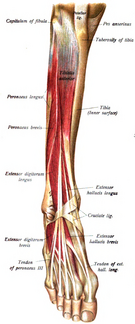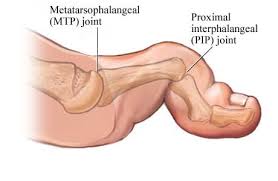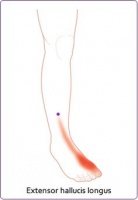Extensor Hallucis Longus: Difference between revisions
No edit summary |
Mohit Chand (talk | contribs) No edit summary |
||
| (17 intermediate revisions by 9 users not shown) | |||
| Line 1: | Line 1: | ||
<div class="editorbox">'''Original Editor '''- [[User:Esraa Mohamed Abdullzaher|Esraa Mohamed Abdullzaher]] | <div class="editorbox">'''Original Editor '''- [[User:Esraa Mohamed Abdullzaher|Esraa Mohamed Abdullzaher]] | ||
'''Top Contributors''' - {{Special:Contributors/{{FULLPAGENAME}}}} | '''Top Contributors''' - {{Special:Contributors/{{FULLPAGENAME}}}} | ||
</div> | </div> | ||
= Introduction = | = Introduction = | ||
The Extensor hallucis longus (EHL) muscle is a key muscle located in the anterior compartment of the lower leg. It is responsible for extending the big toe at both the metatarsophalangeal and interphalangeal joints.<ref name=":1">Lezak B, Summers S. Anatomy, Bony Pelvis and Lower Limb: Extensor Hallucis Longus Muscle. In: StatPearls [Internet]. Treasure Island (FL): StatPearls Publishing; 2024 Jan-. Available from: <nowiki>https://www.ncbi.nlm.nih.gov/books/NBK539875/</nowiki> | |||
Last accessed- 15/5/2024</ref> | |||
= Anatomy = | = Anatomy = | ||
{{#ev:youtube|nFa6uiSVYzo|300}}<ref>Kenhub - Learn Human Anatomy. Extensor Hallucis Longus Muscle - Origin, Insertion, Innervation & Function - Kenhub. Available from: https://www.youtube.com/watch?v=nFa6uiSVYzo [last accessed 27/3/2022]</ref> | |||
[[ | == Origin == | ||
[[File:Sobo 1909 306.png|right|325x325px]] | |||
From the middle two quarters of the anterior surface of [[fibula]] and the adjacent interosseous membrane.<ref name="Muscles: Testing and Function, with Posture and Pain. Florence P,Elizabeth K, Patricia G,Mary M, William A.5th ed.2005.">Muscles: Testing and Function, with Posture and Pain. fckLRFlorence P,Elizabeth K, Patricia G,Mary M, William A.5th ed.2005.</ref> | |||
== Insertion == | |||
EHL passes deep to the extensor retinaculum before inserting at the base of the distal phalanx of the big toe.<ref name="Muscles: Testing and Function, with Posture and Pain. Florence P,Elizabeth K, Patricia G,Mary M, William A.5th ed.2005.">Muscles: Testing and Function, with Posture and Pain. fckLRFlorence P,Elizabeth K, Patricia G,Mary M, William A.5th ed.2005.</ref><ref name=":0">Moore KL, Dalley AF, Agur A. Clinically oriented anatomy. 7th ed. Philadelphia, PA: Lippincott Williams and Wilkins; 2013.</ref><br> | |||
== Nerve Supply == | == Nerve Supply == | ||
Deep peroneal L4 | Deep peroneal nerve L4 -L5.<ref name="Muscles: Testing and Function, with Posture and Pain. Florence P,Elizabeth K, Patricia G,Mary M, William A.5th ed.2005." /><ref name=":0" /> | ||
== Action == | == Action == | ||
Extends the | Extends the metatarsophalangeal and interphalangeal joints of the big toe and assist in the in the inversion of the foot and dorsiflexion of the ankle.<ref name="Muscles: Testing and Function, with Posture and Pain. Florence P,Elizabeth K, Patricia G,Mary M, William A.5th ed.2005.">Muscles: Testing and Function, with Posture and Pain. fckLRFlorence P,Elizabeth K, Patricia G,Mary M, William A.5th ed.2005.</ref> | ||
== Artery == | |||
Anterior tibial artery<ref name=":1" /> | |||
= Manual Muscle test = | |||
Patient position: supine or sitting. | |||
Test: extension of metatarsophalangeal and interphalangeal joints of the big toe. | |||
Pressure: against dorsal surface of distal phalanges of the big toe in the direction of flexion.<ref name="Muscles: Testing and Function, with Posture and Pain. Florence P,Elizabeth K, Patricia G,Mary M, William A.5th ed.2005.">Muscles: Testing and Function, with Posture and Pain. fckLRFlorence P,Elizabeth K, Patricia G,Mary M, William A.5th ed.2005.</ref> | |||
== | == Palpation == | ||
{{#ev:youtube|QLX37MsdeSE|300}}<ref> | |||
Blackriver & Bootsma Education. Muscle Palpation -Muscle Palpation - Extensor Hallucis Longus [Anterior Compartment of The Leg]Available from: https://www.youtube.com/watch?v=QLX37MsdeSE [last accessed 15/5/2024]</ref> | |||
= | = Paralysis of EHL = | ||
In the paralysis of EHL, the action of EHB is dominant, the distal phalanx doesn't extend, and the proximal phalanx extend in the direction of adduction.<ref name="Muscles: Testing and Function, with Posture and Pain. Florence P,Elizabeth K, Patricia G,Mary M, William A.5th ed.2005.">Muscles: Testing and Function, with Posture and Pain. fckLRFlorence P,Elizabeth K, Patricia G,Mary M, William A.5th ed.2005.</ref> | |||
= | = Effect of Weakness = | ||
Weakness of EHL decreases extension at the metatarsophalangeal and interphalangeal joints. As it is the only muscle for the extension of interphalangeal joint, decreased dorsiflexion of the great toe is diagnostic for EHL weakness. | |||
During normal locomotion, an individual contacts the ground with the heel of the foot first. The ground reaction force applies a plantarflexion moment to the whole foot, which is resisted by all of the dorsiflexors. Weakness of the EHL diminishes an individual’s ability to control the descent of the medial portion of the foot, particularly the great toe. | |||
Patients with weakness of the extensor hallucis longus also report that the toe tends to fold under the foot when they are pulling on socks or shoes and can cause tripping.<ref name="Carol A.Oatis . kinesiology the mechanics and pathomechanics of human movement , 2003" /> | |||
= | = Effect of Tightness = | ||
Tightness of the EHL pulls the metatarsophalangeal joint of the great toe into extension, which, as in the fingers and thumb, tends to produce flexion at the interphalangeal joint, leading to a claw toe deformity. | |||
Hyperextension of the great toe pulls the plantar plate distally, exposing the metatarsal head to excessive loads and producing pain. Similarly, hyperextension of the metatarsophalangeal joint pulls the interphalangeal joint into the toe box of a shoe, causing pain and calluses, or corns, on the dorsal surface of the interphalangeal joint. | |||
Claw Deformities of the toes:<br>Claw toe deformities in a foot with sensation are quite painful. Claw deformities in a foot without sensation put the individual at risk of skin breakdown as the result of increased pressure under the metatarsal heads and between the dorsal surfaces of the toes and the shoe.<ref name="Carol A.Oatis . kinesiology the mechanics and pathomechanics of human movement , 2003">Carol A.Oatis . kinesiology the mechanics and pathomechanics of human movement , 2003</ref><br> | |||
[[Image:Claw with words.jpg|center]] | |||
= Trigger point referral = | |||
EHL refers pain to the distal aspect of the 1st metatarsal and great toe, as well as the dorsum of the foot. It may reach up the leg as far as the point. These points are located just distal to the junction between the middle and distal thirds of the leg, just anterior to the fibula. The patient may also complain of persistent dorsal foot pain.<ref name="Steven E.Jurch. clinical massage therapy: assessment and treatment of orthopedic conditions,2007.">Steven E.Jurch. clinical massage therapy: assessment and treatment of orthopedic conditions,2007.</ref> | |||
[[Image:6cc49f90d5372e22fa255b88248ba69d.jpg|center|200x200px]] | |||
= | == Treatment == | ||
'''Strengthening''' | |||
Here are some effective exercises to strengthen the big toe, backed by research evidence:<ref>Tourillon, Romain et al. “How to Evaluate and Improve Foot Strength in Athletes: An Update.” ''Frontiers in sports and active living'' vol. 1 46. 11 Oct. 2019, | |||
Available from: [[/www.ncbi.nlm.nih.gov/pmc/articles/PMC7739583/|How to Evaluate and Improve Foot Strength in Athletes: An Update - PMC (nih.gov)]] | |||
Last Accessed- 15/5/2024</ref> | |||
* Big Toe Lift- This exercise targets the extensor hallucis longus and brevis muscles. Raise your big toe while keeping the other toes flat on the floor. Avoid letting the foot roll out or scrunching the little toes. Practice this to improve isolation and range of motion. | |||
* Big Toe Extension with Heel Raises- Perform heel raises while keeping the big toe extended. A towel roll under the toes can help with mobility. This strengthens the big toe extensor muscles in a functional, weight-bearing position. | |||
* Short Foot Exercise- Pull the base of the big toe towards the heel to create an arch, keeping the toes flat. This activates the intrinsic foot muscles like the abductor hallucis that stabilize the big toe joint. | |||
* Towel Curls- Sitting or standing, use your toes to slowly curl a towel or piece of paper under your foot. This strengthens the toe flexor muscles, including the flexor hallucis brevis. | |||
* Resistance Band Big Toe Abduction- Loop a resistance band around your big toe and abduct it against the band's resistance. Keep the other toes relaxed. This isolates the abductor hallucis muscle. Performing these exercises 2-3 times per week can improve big toe strength and mobility. Start with 2-3 sets of 10-15 reps. Gradually increase difficulty by adding resistance bands or holding for longer. Proper technique is key to isolating the big toe muscles. | |||
{{#ev:youtube|RiErCxACmWw|300}}<ref>Carter Physiotherapy. Big Toe Extension. Available from: https://www.youtube.com/watch?v=RiErCxACmWw [last accessed 27/3/2022]</ref> | |||
= | {{#ev:youtube|95ISH9Q3X4w|300}}<ref>Restore Plus Physical Therapy & Rehabilitation. Toe Extensor Strengthening Exercise. Available from: https://www.youtube.com/watch?v=95ISH9Q3X4w [last accessed 27/3/2022]</ref> | ||
<br> | |||
== Stretching == | |||
{{#ev:youtube|h2kaEOd3GcI|300}}<ref>Northwest Foot & Ankle. Toe Extensor Stretch with Dr Ray McClanahan. Available from: https://www.youtube.com/watch?v=h2kaEOd3GcI [last accessed 27/3/2022]</ref><br> | |||
= References = | = References = | ||
<references /> | <references /> | ||
[[Category:Anatomy]] | |||
[[Category:Muscles]] | |||
Latest revision as of 17:14, 15 May 2024
Top Contributors - Esraa Mohamed Abdullzaher, Mohit Chand, Patti Cavaleri, George Prudden, 127.0.0.1, WikiSysop, Simisola Ajeyalemi, Kim Jackson and Joao Costa
Introduction[edit | edit source]
The Extensor hallucis longus (EHL) muscle is a key muscle located in the anterior compartment of the lower leg. It is responsible for extending the big toe at both the metatarsophalangeal and interphalangeal joints.[1]
Anatomy[edit | edit source]
Origin[edit | edit source]
From the middle two quarters of the anterior surface of fibula and the adjacent interosseous membrane.[3]
Insertion[edit | edit source]
EHL passes deep to the extensor retinaculum before inserting at the base of the distal phalanx of the big toe.[3][4]
Nerve Supply[edit | edit source]
Deep peroneal nerve L4 -L5.[3][4]
Action[edit | edit source]
Extends the metatarsophalangeal and interphalangeal joints of the big toe and assist in the in the inversion of the foot and dorsiflexion of the ankle.[3]
Artery[edit | edit source]
Anterior tibial artery[1]
Manual Muscle test[edit | edit source]
Patient position: supine or sitting.
Test: extension of metatarsophalangeal and interphalangeal joints of the big toe.
Pressure: against dorsal surface of distal phalanges of the big toe in the direction of flexion.[3]
Palpation[edit | edit source]
Paralysis of EHL[edit | edit source]
In the paralysis of EHL, the action of EHB is dominant, the distal phalanx doesn't extend, and the proximal phalanx extend in the direction of adduction.[3]
Effect of Weakness[edit | edit source]
Weakness of EHL decreases extension at the metatarsophalangeal and interphalangeal joints. As it is the only muscle for the extension of interphalangeal joint, decreased dorsiflexion of the great toe is diagnostic for EHL weakness.
During normal locomotion, an individual contacts the ground with the heel of the foot first. The ground reaction force applies a plantarflexion moment to the whole foot, which is resisted by all of the dorsiflexors. Weakness of the EHL diminishes an individual’s ability to control the descent of the medial portion of the foot, particularly the great toe.
Patients with weakness of the extensor hallucis longus also report that the toe tends to fold under the foot when they are pulling on socks or shoes and can cause tripping.[6]
Effect of Tightness[edit | edit source]
Tightness of the EHL pulls the metatarsophalangeal joint of the great toe into extension, which, as in the fingers and thumb, tends to produce flexion at the interphalangeal joint, leading to a claw toe deformity.
Hyperextension of the great toe pulls the plantar plate distally, exposing the metatarsal head to excessive loads and producing pain. Similarly, hyperextension of the metatarsophalangeal joint pulls the interphalangeal joint into the toe box of a shoe, causing pain and calluses, or corns, on the dorsal surface of the interphalangeal joint.
Claw Deformities of the toes:
Claw toe deformities in a foot with sensation are quite painful. Claw deformities in a foot without sensation put the individual at risk of skin breakdown as the result of increased pressure under the metatarsal heads and between the dorsal surfaces of the toes and the shoe.[6]
Trigger point referral[edit | edit source]
EHL refers pain to the distal aspect of the 1st metatarsal and great toe, as well as the dorsum of the foot. It may reach up the leg as far as the point. These points are located just distal to the junction between the middle and distal thirds of the leg, just anterior to the fibula. The patient may also complain of persistent dorsal foot pain.[7]
Treatment[edit | edit source]
Strengthening
Here are some effective exercises to strengthen the big toe, backed by research evidence:[8]
- Big Toe Lift- This exercise targets the extensor hallucis longus and brevis muscles. Raise your big toe while keeping the other toes flat on the floor. Avoid letting the foot roll out or scrunching the little toes. Practice this to improve isolation and range of motion.
- Big Toe Extension with Heel Raises- Perform heel raises while keeping the big toe extended. A towel roll under the toes can help with mobility. This strengthens the big toe extensor muscles in a functional, weight-bearing position.
- Short Foot Exercise- Pull the base of the big toe towards the heel to create an arch, keeping the toes flat. This activates the intrinsic foot muscles like the abductor hallucis that stabilize the big toe joint.
- Towel Curls- Sitting or standing, use your toes to slowly curl a towel or piece of paper under your foot. This strengthens the toe flexor muscles, including the flexor hallucis brevis.
- Resistance Band Big Toe Abduction- Loop a resistance band around your big toe and abduct it against the band's resistance. Keep the other toes relaxed. This isolates the abductor hallucis muscle. Performing these exercises 2-3 times per week can improve big toe strength and mobility. Start with 2-3 sets of 10-15 reps. Gradually increase difficulty by adding resistance bands or holding for longer. Proper technique is key to isolating the big toe muscles.
Stretching[edit | edit source]
References[edit | edit source]
- ↑ 1.0 1.1 Lezak B, Summers S. Anatomy, Bony Pelvis and Lower Limb: Extensor Hallucis Longus Muscle. In: StatPearls [Internet]. Treasure Island (FL): StatPearls Publishing; 2024 Jan-. Available from: https://www.ncbi.nlm.nih.gov/books/NBK539875/ Last accessed- 15/5/2024
- ↑ Kenhub - Learn Human Anatomy. Extensor Hallucis Longus Muscle - Origin, Insertion, Innervation & Function - Kenhub. Available from: https://www.youtube.com/watch?v=nFa6uiSVYzo [last accessed 27/3/2022]
- ↑ 3.0 3.1 3.2 3.3 3.4 3.5 Muscles: Testing and Function, with Posture and Pain. fckLRFlorence P,Elizabeth K, Patricia G,Mary M, William A.5th ed.2005.
- ↑ 4.0 4.1 Moore KL, Dalley AF, Agur A. Clinically oriented anatomy. 7th ed. Philadelphia, PA: Lippincott Williams and Wilkins; 2013.
- ↑ Blackriver & Bootsma Education. Muscle Palpation -Muscle Palpation - Extensor Hallucis Longus [Anterior Compartment of The Leg]Available from: https://www.youtube.com/watch?v=QLX37MsdeSE [last accessed 15/5/2024]
- ↑ 6.0 6.1 Carol A.Oatis . kinesiology the mechanics and pathomechanics of human movement , 2003
- ↑ Steven E.Jurch. clinical massage therapy: assessment and treatment of orthopedic conditions,2007.
- ↑ Tourillon, Romain et al. “How to Evaluate and Improve Foot Strength in Athletes: An Update.” Frontiers in sports and active living vol. 1 46. 11 Oct. 2019, Available from: How to Evaluate and Improve Foot Strength in Athletes: An Update - PMC (nih.gov) Last Accessed- 15/5/2024
- ↑ Carter Physiotherapy. Big Toe Extension. Available from: https://www.youtube.com/watch?v=RiErCxACmWw [last accessed 27/3/2022]
- ↑ Restore Plus Physical Therapy & Rehabilitation. Toe Extensor Strengthening Exercise. Available from: https://www.youtube.com/watch?v=95ISH9Q3X4w [last accessed 27/3/2022]
- ↑ Northwest Foot & Ankle. Toe Extensor Stretch with Dr Ray McClanahan. Available from: https://www.youtube.com/watch?v=h2kaEOd3GcI [last accessed 27/3/2022]









